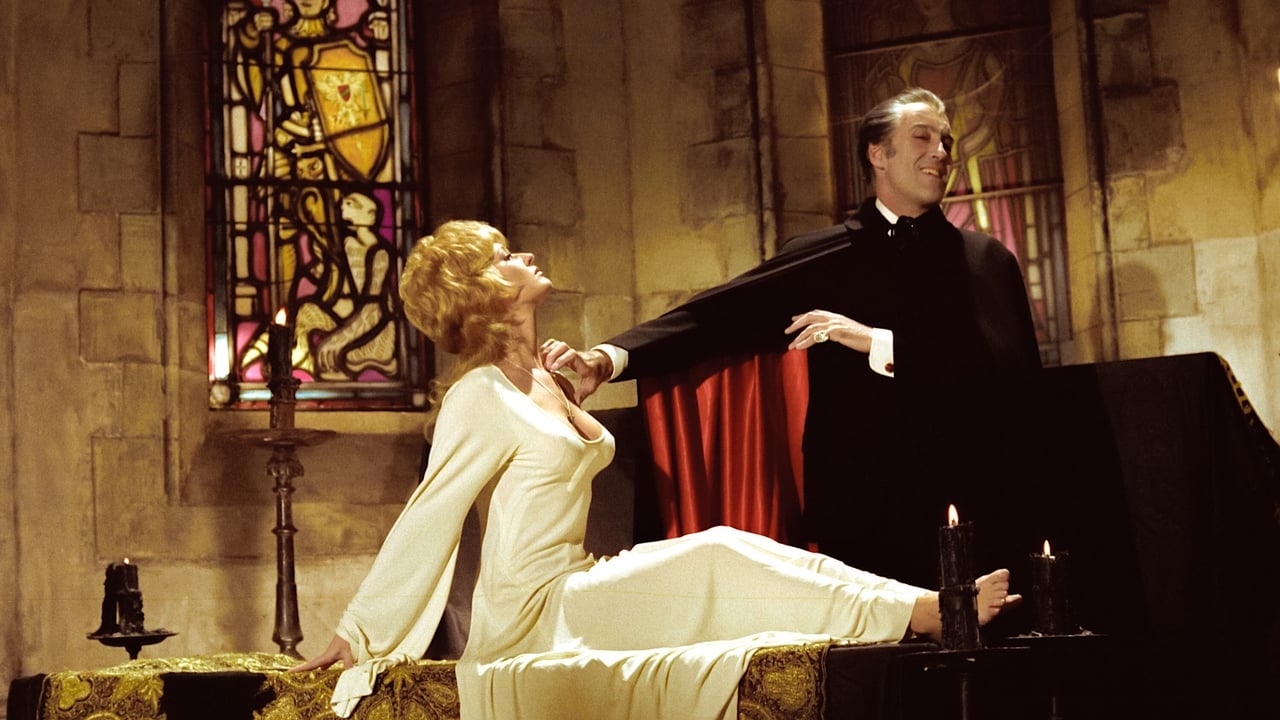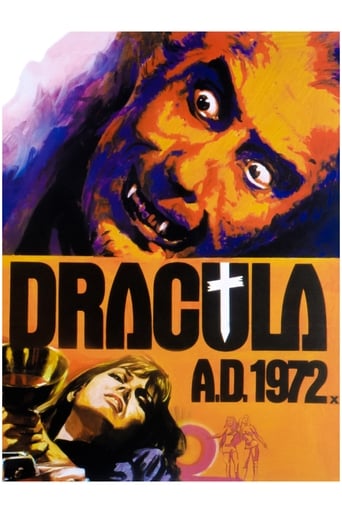

n my opinion it was a great movie with some interesting elements, even though having some plot holes and the ending probably was just too messy and crammed together, but still fun to watch and not your casual movie that is similar to all other ones.
... View MoreI wanted to like it more than I actually did... But much of the humor totally escaped me and I walked out only mildly impressed.
... View MoreStory: It's very simple but honestly that is fine.
... View MoreI enjoyed watching this film and would recommend other to give it a try , (as I am) but this movie, although enjoyable to watch due to the better than average acting fails to add anything new to its storyline that is all too familiar to these types of movies.
... View MoreThe seventh in the series of Hammer vampire films is refreshed by placing the action in the present, specifically in 1972. Naive satanist, thirsty for power and immortality, performs the ritual and revives Count exactly 100 years after Van Helsing killed him, and Dracula moves to take revenge on Van Helsing family. The main roles are again performed by Christopher Lee and Peter Cushing, and there are also a few hippie beauties. The acting and directing are satisfying, and the first half of the film has a strong seal of the seventies. The music is totally inappropriate for the genre, but all together it is quite fun. In the second half things go downhill and the movie turns into a bad vampire cliché. All in all, a movie worth watching once.7/10
... View MoreHippies in '70s England resurrect Dracula and a descendant of Van Helsing's must do something about it. Weak later Hammer effort, desperate to stay trendy, has one major thing going for it: the reunion of Peter Cushing and Christopher Lee in a Dracula movie. All the dated hippie stuff is a relic of its era that may provide a few unintended laughs but does nothing to contribute to creating a proper horror movie atmosphere. After a strong opening that shows how Dracula was killed in 1872, it's halfway through the movie before we see him again. Then, after he's resurrected, he doesn't do much of anything. Instead, he lets his acolyte (an overacting Christopher Neame) do all the dirty work. Cushing is the best thing about this and all of the best scenes involve him, including his two (sadly just two) scenes with Lee. At least there's also Stephanie Beacham and Caroline Munro providing the pretty. Some of the sets are nice and director Alan Gibson shows he has some flair but there's too many scenes that misfire. For example, scenes with potential (like Dracula's resurrection) are ruined by the "groovy" music used. While there's more wrong with the movie than the music, it would be interesting to see how a re-scoring with a less cheesy soundtrack would help it. All in all, it's worth a look for fans of Hammer and the stars. But it's really a disappointment because there's so little of them, especially Lee. Still, when they are on screen, they're fun to watch.
... View MoreIn the late 1950s Hammer Films revolutionised horror with the likes of 'The Curse of Frankenstein' (1957) and 'Dracula' (1958) which, for the time, pushed boundaries in terms of gore (not least through the knowledgeable use of colour film) and eroticism. They were commercial and critical successes that resurrected a dead genre (pun intended) and opened the door for a boom in horror movies equivalent to that in the 1930s.However, cut to the beginning of the 1970s and society itself had gone from Black and White to Technicolour due to the flowering of the counter-culture which saw all social institutions subject to intense criticism or outright attack and in horror we had seen the all-out assault of George A. Romero's 'Night of the Living Dead' (1968). As a result, recognising that quaint Vampire movies from England just don't get the scares they used to, Hammer tried to change things up. One thing they tried was ditching the subtle but potent eroticism for simply showing more tits and having the women engage in lesbianism. Another, more respectable, thing was to attempt to update the vampire story to make it more relevant to a modern audience. And from this comes 'Dracula AD 1972'.The plot is basically the same as any other of the Dracula sequels that came in the wake of 'Dracula' (1958): the count, dead since his last encounter with Van Helsing is brought back by a dutiful underling and seeks revenge. The film begins with an impressive period piece prologue showing Dracula's staking a hundred years ago and then, panning up, a plane screeches across the sky announcing the updated setting. The film then cuts to an amusing scene where a group of young hip cats (led by the charismatic and aloof Johnny Alucard) have gate-crashed a party and are "terrorising" the owners in the most limp and middle-class way. Later on they talk of where the next far out thrill will come from when Johnny suggests a black mass. They all attend for kicks but get freaked out when Johnny seems to take it too seriously and wants Jessica (family name Van Helsing) played by Stephanie Beacham, to get involved. She declines but the Prince of Darkness is summoned with the aid of another girl and, awakened to the twentieth century, Dracula is out for revenge.The film has been criticised by many as a failed attempt to desperately breathe life into the franchise, and while that charge can't be escaped, the conceit of the film to update Dracula is not a bad one. If anything, the failing of the film is that it didn't go far enough in its updating and still feels like the reserved period pieces which came before just in funky threads and platforms. What's more, director Alan Gibson (who would direct the next attempt to update Dracula with the much worse 'The Satanic Rites of Dracula') is no Terence Fisher and lacks the directorial subtleties which distinguish the earlier features. Still, Peter Cushing and Christopher Lee are sheer class, as always, and raise the film up a notch or two.All told, it's a decent attempt, with some good moments, and manages to be fun ride. However, considering that 'The Exorcist' was around the corner, it's no surprise poor old Dracula couldn't cut it. Which is sad.
... View MoreEngland's Hammer Studios did 9 Dracula or vampire films from 1958-1974:1. Horror of Dracula (1958); 2. Brides of Dracula (1960); 3. Dracula, Prince of Darkness (1966); 4. Dracula has Risen from the Grave (1968); 5. Taste the Blood of Dracula (1970); 6. Scars of Dracula (1970); 7. Dracula A.D. 1972 (1972); 8. The Satanic Rites of Dracula (1973); and 9. The Legend of the 7 Golden Vampires (1974).Christopher Lee plays the Count in all but "The Brides of Dracula" and "The Legend 7 Golden Vampires." Peter Cushing also stars in four entries as Van Helsing.By the time of the seventh film the creative well was apparently running dry and Hammer decided to spice up the series by bringing the Count to present-day London (1972, of course), which was Hammer's response to other successful vampire films at the time taking place in the modern day, such as "The Night Stalker," "Blacula" and "Count Yorga." The story revolves around a group of hip counter-culture youths performing a black mass in an abandoned church for kicks (although the ringleader takes it serious) and they revive the blood-sucking prince of darkness. Havok ensues.Peter Cushing appears as Van Helsing's descendant. Christopher Neame plays the nutjob who performs the black mass with utter relish. Also on hand are the stunning beauties Stephanie Beacham and Caroline Munro. Stephanie plays Van Helsing's daughter and Caroline has a small but significant role. There are a couple of other early-70s hippie babes as well.The first half of the film borrows heavily from the previous "Taste the Blood of Dracula" in that the Count is resurrected in roughly the same manner, although "Taste" is more effective. Which isn't to say that "Dracula A.D. 1972" isn't a decent entry in the series, albeit bizarre. The main problem with the film is that the story doesn't seem to know what to do once Dracula is resurrected. For instance, Cushing's final battle with the Count is fairly lame for various reasons (I don't want to give anything away), not to mention Lee only appears for about 10 minute in the entire film, which is usual for the series, of course.Another problem is the score. It screams "early 70s" in a bad way, but doesn't mesh with what is essentially a serious horror flick. Of course some would cite that as part of its charm. I said "serious horror flick, by the way, because this is not a goofy or campy flick despite the colorful hippie elements and lousy score.What works best is that it's a great period piece. You'll get a groovy glimpse of England's counter-culture, including the hippie girls and a live performance by the band Stoneground (who didn't go anywhere beyond this movie, likely because their sound & style was already passe by 1972). So, the first half is fun and compelling, whereas the second half just sort of goes through the motions and peters out.BOTTOM LINE: "Dracula A.D. 1972" is hard to rate because, despite the mediocre-ness of the story's second half, the film is a fun experience with numerous highlights. Hence, as a Dracula story I give it a C+, but for entertainment value I give it a solid B or B+.The film runs 96 minutes and was shot in England.GRADE: B-
... View More